The Chukar is a game bird with a round, small head, short legs, and a plump body. Their wings are rounded and broad in flight, and their tails are square. These birds are chicken-like, smaller than a Ring-necked Pheasant, and larger than a California Quail.
This bird is originally from Eurasia. It lives in the high desert plains of western North America as well as New Zealand and Hawaii. It’s named after the call it makes, which echoes across the dry, rocky slopes where it lives. It can quickly scamper and run up steep terrain with the speed and agility of a mountain goat. This skill is where it got its nickname from “devil bird.” Hunters gave them this nickname for the chase it provides.
On this page
Identification
Chukars can be hard to spot because they blend in exceptionally well with their rocky surroundings, even with their bold markings!
Additionally, they’re naturally very wary. March to May is one of the best times to go looking for this bird because this is when males call from noticeable rocks, increasing your likelihood of seeing one. In the summer, look for groups of these birds, called coveys, around water sources like streams, ponds, and small pools.
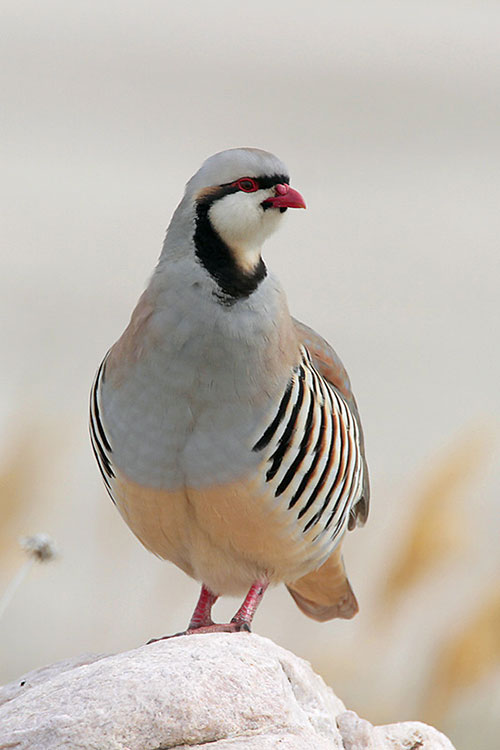
Photograph © Greg Lavaty
Adult male Chukars have bold, vertical black bars on their sides and are sandy brown overall. Additionally, they have red bills, red eyerings, white cheeks, white throats, and a dark band through the eyes that wraps around the throat and cheeks.
Chukars are 13.4 to 15.0 inches (34 to 38 centimeters) long, weigh 19.0 to 27.0 ounces (538 to 765 grams), and have a wingspan of 20.1 inches (51 centimeters).
Adult Female Chukars look identical to breeding male Chukars. They have bold, vertical black bars on their sides and are sandy brown overall. Additionally, they have red bills, red eyerings, white cheeks, white throats, and a dark band through the eyes that wraps around the throat and cheeks. They’re the same size and length and have the same wingspan as breeding males. They also weigh the same amount.
Food
Chukars forage for food on the ground. Chicks primarily consume insects, but when they reach adulthood, they’re mainly vegetarian. In North America, Chukars prefer to consume the seeds and leaves of perennial and annual grasses.
Additionally however, they will consume pinyon pine seeds, sunflower seeds, rough fiddleneck seeds, and tansy mustard seeds. In the fall and winter, Chukars mostly consume grass leaves.
Nesting and Eggs
Chukars place their nests near brush and rocks to hide them.
Nests can be on mountain slopes, under saltbush, sagebrush, desert tea, or goldenbush. Chukar nests are very simple, only depressions that have been scratched in the ground and lined with breast feathers and dry grasses.
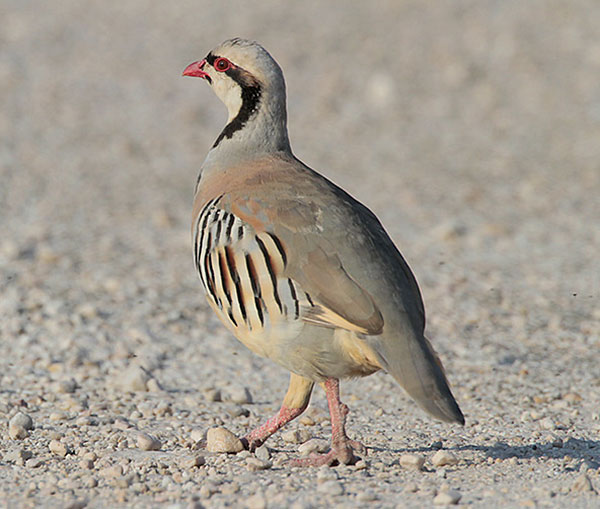
The sexes are similar, though females lack leg spurs.
Female Chukars are the ones that do most of the nest care, although some males will stay with their mates and help them during the nesting season.
- The clutch size is 10 to 21 eggs.
- Chukars have 1 brood per breeding season.
- Egg length can be anywhere from 1.5 to 1.9 inches (3.7 to 4.8 centimeters).
- Egg width can be anywhere from 1.2 to 1.3 inches (3 to 3.2 centimeters).
- Eggs range from pale white to coffee-colored, with reddish, yellowish, or purplish brown spots.
Current Situation
Chukars were introduced to the U.S. in 1893 from Pakistan, but only a few survived.
Additional introductions from 1931 and 1970 to the western portions of the U.S. helped establish wild populations in California, Nevada, Idaho, Washington, Colorado, Arizona, Wyoming, Montana, Utah, Oregon, as well as British Columbia.
These birds also successfully colonized the six main islands of Hawaii after introductions in the 1900s.
They’re now a common bird in Canada and the United States.
They have an estimated breeding population of 7.8 million, meaning they’re a species of low concern.
Chukars live in high-elevation shrublands between 4,000 and 13,000 feet in North America.’
They usually occur on relatively steep and rocky hillsides that have some grasses, forbs, and brush. These birds also inhabit deserts and barren plateaus with scattered grasses. In most of their habitats, big sagebrush is the primary plant species, which can be an essential part of their diet.
These birds tend to stick by water, especially during the hot summers. However, in harsh winters with a lot of snowfall, Chukars may travel down into towns or agricultural fields to look for food.
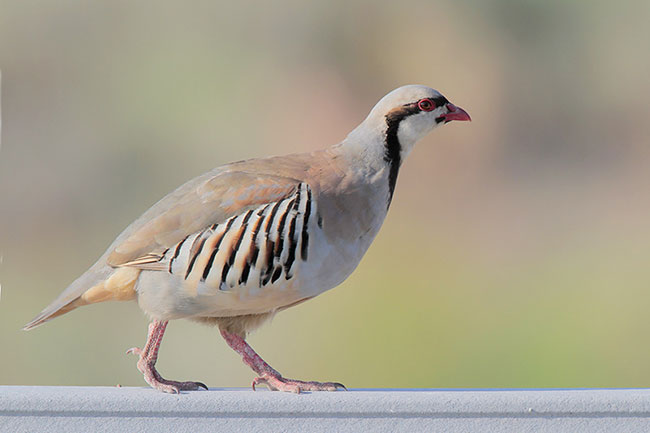
Facts
- Chukars take advantage of any source of water they can find because they live in such dry country. They can be found around ponds, rivers, springs, etc. During the scorching summer months, they can sometimes be found in mineshafts 10 feet below the ground.
- The Chukar was named after its very noisy song that sounds like it’s saying ‘chuck-chuck-chukar-chukar.’
- Chukars will take a dust bath almost every day to keep their feathers in perfect shape. To take a dust bath, they’ll create a shallow depression in the ground and scratch and toss dust over their bodies.
- Chukars are mainly vegetarian when they reach adult age.
- The Chukar is the national bird of Iraq and Pakistan.
Similar Species
The Chukar has features that are similar to other bird species. Here are some similar species:
Gray Partridge – Chukar’s have red bills and bold black stripes, while The Gray Partridge is grayer overall and lacks the stripes and the red bill.
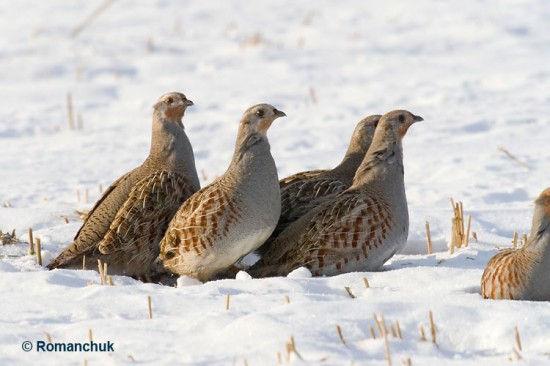
Gray Partridges
California Quail – Female California Quails are not sandy brown like a Chukar. Instead, they’re a darker brown. Additionally, they lack the stripes and the red bill that Chukar’s have.
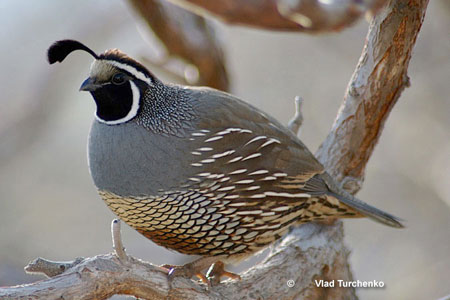
California Quail
Mountain Quail – The Mountain Quail is mostly rich brown and gray instead of sandy brown. Additionally, they have brown flanks with white stripes instead of pale flanks with black stripes.
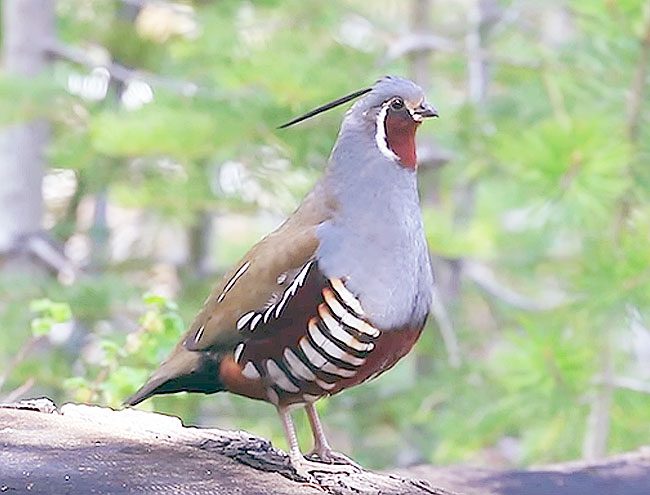
Mountain Quail
Frequently Asked Questions About Chukar
Is Chukar a quail?
No, the Chukar is not a quail; it’s a partridge. Chukars tend to be larger and more social than Quail.
Are Chukars native to the US?
Chukars are not native to the U.S. Chukars were introduced to the U.S. in 1893 from Pakistan, but few survived. Additional introductions from 1931 and 1970 to the western portions of the U.S. helped establish wild populations in California, Nevada, Idaho, Washington, Colorado, Arizona, Wyoming, Montana, Utah, Oregon,
Where are Chukars found?
Chukars live in high-elevation shrublands between 4,000 and 13,000 feet in North America. They usually occur on relatively steep and rocky hillsides that have some grasses, forbs, and brush.
These birds also inhabit deserts and barren plateaus with scattered grasses. These birds tend to stick by water, especially during the hot summers. In harsh winters with a lot of snowfall, Chukars may travel down into towns or agricultural fields to look for food.
How long do Chukars live?
Chukars can live to be anywhere from 3 to 5 years old. Of course, there are exceptions, but the average Chukar lives to that age.

